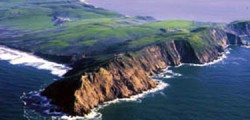The bizarre landforms called badlands are, despite the uninviting name, a masterpiece of water and wind sculpture. They are near deserts of a special kind, where rain is infrequent, the bare rocks are poorly consolidated and relatively uniform in their resistance to erosion, and runoff water washes away large amounts of sediment. On average, the White River Badlands of South Dakota erode one inch per year. They are formidable redoubts of stark beauty where the delicate balance between creation and decay, that distinguishes so much geologic art, is manifested in improbable landscapes – near moonscapes – whose individual elements seem to defy gravity. Erosion is so rapid that the landforms can change perceptibly overnight as a result of a single thunderstorm.
Photos taken Sunday, August 30, 2009. Click any image for larger versions.








 Point Reyes National Seashore contains unique elements of biological and historical interest in a spectacularly scenic panorama of thunderous ocean breakers, open grasslands, bushy hillsides and forested ridges. Native land mammals number about 37 species and marine mammals augment this total by another dozen species. The biological diversity stems from a favorable location in the middle of California and the natural occurrence of many distinct habitats. Nearly 20% of the State’s flowering plant species are represented on the peninsula and over 45% of the bird species in North America have been sighted.
Point Reyes National Seashore contains unique elements of biological and historical interest in a spectacularly scenic panorama of thunderous ocean breakers, open grasslands, bushy hillsides and forested ridges. Native land mammals number about 37 species and marine mammals augment this total by another dozen species. The biological diversity stems from a favorable location in the middle of California and the natural occurrence of many distinct habitats. Nearly 20% of the State’s flowering plant species are represented on the peninsula and over 45% of the bird species in North America have been sighted. 




 Stretched over 70 miles of barrier islands, Cape Hatteras National Seashore is a fascinating combination of natural and cultural resources, and provides a wide variety of recreational opportunities. Once dubbed the “Graveyard of the Atlantic” for its treacherous currents, shoals, and storms, Cape Hatteras has a wealth of history relating to shipwrecks, lighthouses, and the U.S. Lifesaving Service. These dynamic islands provide a variety of habitats and are a valuable wintering area for migrating waterfowl. The park’s fishing and surfing are considered the best on the east coast.
Stretched over 70 miles of barrier islands, Cape Hatteras National Seashore is a fascinating combination of natural and cultural resources, and provides a wide variety of recreational opportunities. Once dubbed the “Graveyard of the Atlantic” for its treacherous currents, shoals, and storms, Cape Hatteras has a wealth of history relating to shipwrecks, lighthouses, and the U.S. Lifesaving Service. These dynamic islands provide a variety of habitats and are a valuable wintering area for migrating waterfowl. The park’s fishing and surfing are considered the best on the east coast.


